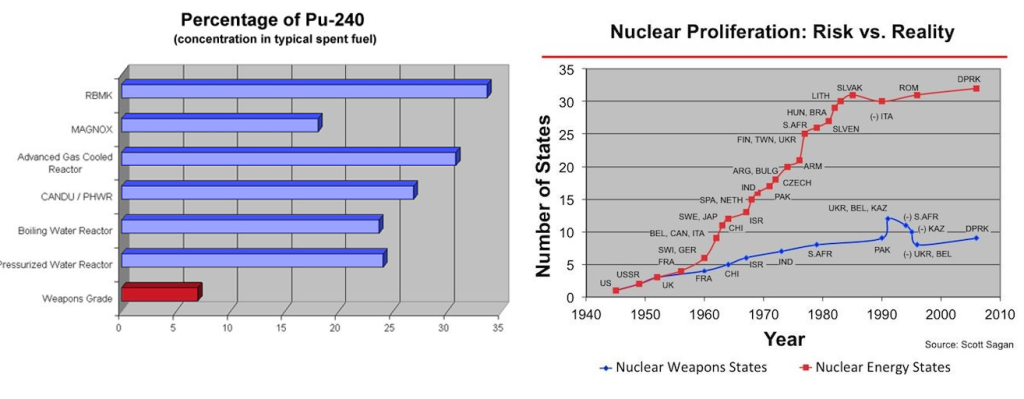Myth: Civil and military uses of nuclear energy cannot be separated #
Fact: It is a common myth that nuclear weapons technology is dependent on nuclear reactors.
History shows no correlation between the number of countries with nuclear energy and countries with nuclear weapons [1]. Furthermore, a nuclear power plants is not suitable for making weapons material. The plutonium inevitably produced in a power reactors is so isotopically contaminated that it is practically no longer suitable for nuclear weapons.
Lots of technologies can be used both for weapons production and peaceful purposes. Fertilizer factories ensure that we can feed millions of people in the world, can potentially be used to make bombs. Chemical factories of all kinds produce things for e.g. medicine, but can also be designed to produce chemical weapons. Even a metal factory can also produce ammunition.
The world would be a far worse place if we allowed that kind of fear to dominate what technologies we will allow.
Read more: NUCLEAR ENERGY DOES NOT INCREASING NUCLEAR WEAPONS

Myths: Fast breeder reactors increase the dangers of nuclear proliferation #
Fact: Fast breeder reactors can produce plutonium if desired. However, they can be built in such a way that this incubated plutonium is in no way weapons grade in normal operation due to the isotopic composition. Converting the breeder operation to weapons-grade plutonium would be considerably more complex than producing weapons-grade uranium through enrichment, and would also be noticed very quickly by nuclear regulators [2].
Myth: Small Modular Reactors (SMRs) may increase the profiliferation risk #
Fact: Apart from the risk being practically non-existent to start with, some SMR designs such as Terrestrial Energy’s have a sealed reactor core which does not give access to nuclear fuel material, either as fresh uranium or as spent fuel [3].
Myth: Radioactive materials from nuclear reactors can be misused for dirty bombs. #
Fact: Using fission products for dirty bombs couldn’t be more pointless. First, these are extremely difficult to obtain. Secondly also extremely difficult to process. Third, they are a vary big, bulky weapon taht wouldn’t be much more poweful than its own weight in dynamite and extremely ineffective when distributed over a large area. It would be fairly local.
I might spread some plutonium, but its the radio-toxicit is not all that high. Given it’ primarily an alpha emitter, it need to be inhaled or ingested to cause harm. We’ve actually experienced some weapons accidents that spread plutonium in a local area before. They weren’t the end of the world.
Arsenic, cyanide, aldrin, DDT, dioxin – the list of substances that are “better” for a dirty bomb is endless. With them, “success” is guaranteed. Especially recommended: Methyl isocyanate – volatile at room temperature, reacts with water and even explosively with air. It was accidentally released at a chemical plant in Bhopal, India – thousands died immediately, tens of thousands later.




